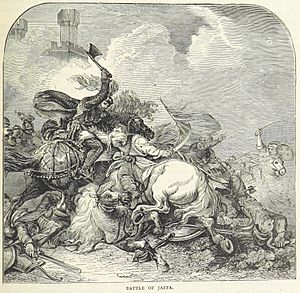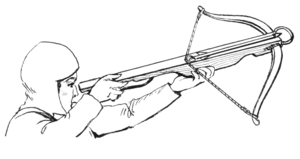Battle of Jaffa (1192) facts for kids
Quick facts for kids Battle of Jaffa |
|||||||
|---|---|---|---|---|---|---|---|
| Part of the Third Crusade | |||||||
 |
|||||||
|
|||||||
| Belligerents | |||||||
| Angevin Empire Republic of Genoa Republic of Pisa |
Ayyubids | ||||||
| Commanders and leaders | |||||||
| Richard I, King of England | Saladin, Sultan of Egypt and Syria | ||||||
| Strength | |||||||
| An unknown number of the garrison of Jaffa 54 Knights, 300-500 infantry, 2,000 Genoese and Pisan crossbowmen + unknown number of sailors (only the numbers of knights and Italians are recorded in primary sources) |
7,000 to 10,000 heavy and light cavalry | ||||||
| Casualties and losses | |||||||
| at least 2 dead, many wounded | 700 dead + 1500 horses | ||||||
The Battle of Jaffa was an important fight during the Crusades. It happened between the army of Sultan Saladin and the Crusader forces. These forces were led by King Richard I of England, also known as Richard the Lionheart. This battle was the very last major fight of the Third Crusade. After it, Saladin and King Richard finally agreed to a truce, which is like a peace agreement.
Even though the Crusaders did not get Jerusalem back, Christian pilgrims were allowed to visit the city. The Crusaders also kept control of a long strip of land. This land stretched from Beirut all the way to Jaffa. The Battle of Jaffa was a key moment. It made Saladin agree to stop fighting right away. It also showed how determined Saladin was and how brave and smart Richard was in battle. This was the last time these two great leaders fought each other. The battle made sure the Crusaders stayed strong in southern Palestine.
Contents
Why the Battle of Jaffa Happened
After the Battle of Arsuf
After the Battle of Arsuf on September 7, 1191, the Crusader army moved to Jaffa. The Crusaders took over Jaffa and made its defenses stronger. They hoped Jaffa would be their main base. From here, they planned to try and take back Jerusalem.
As winter came in 1191, Richard the Lionheart and Saladin talked about peace. But their talks didn't lead to anything right away.
Marching Towards Jerusalem
In late November 1191, the Crusader army marched towards Jerusalem. In early December, Saladin's leaders wanted him to send most of his army home. He did this on December 12. When Richard found out, he moved his army forward. They spent Christmas at Latrun. Then, they marched to Beit Nuba, which was only 12 miles from Jerusalem.
The people in Jerusalem were very worried. If the Crusaders had arrived, the city might have fallen quickly. But the weather was terrible. It was very cold with heavy rain and hail. The bad weather, plus the fear of being trapped, made Richard decide to go back to the coast.
Winter and More Talks
During the winter, Richard's men fixed up Ascalon. Saladin had destroyed its walls earlier. In the spring of 1192, talks continued, and small fights broke out. The Crusader army tried to reach Jerusalem again. They even saw the city. But they had to turn back because their own leaders disagreed.
Around this time, Richard heard bad news from home. His brother John and the French king, Philip Augustus, were causing trouble. As summer arrived, Richard knew he had to go back to England. He needed to protect his own kingdom.
Who Controlled Jaffa?
Saladin Takes Jaffa Back
By July 5, 1192, Richard started to leave the Holy Land. He realized that even if Jerusalem was captured, it would be hard to defend. So, he began to pull his Crusader forces out of enemy lands.
Right after Richard left, Saladin saw his chance. He was still upset about losing at Arsuf. On July 27, Saladin started a siege of Jaffa. Jaffa had been Richard's base for his march towards Jerusalem. The soldiers defending Jaffa were surprised. But they fought bravely against many more enemies. Saladin's soldiers broke through the walls after three days of fierce fighting. Only Jaffa's citadel (a strong fortress) held out. The remaining Crusaders managed to send a message asking for help.
Richard's Surprise Attack from the Sea
Richard quickly gathered a small army. It included many Italian sailors. He rushed south to Jaffa. When he saw Muslim flags on the walls, he thought the town was lost. But then, a Crusader soldier swam out to Richard's ship. He told Richard that the citadel was still holding on.
Richard, still in his sailor's shoes, jumped into the sea. He waded through the waves to reach the beach. The King showed his amazing bravery again. He led 54 knights, a few hundred foot soldiers, and about 2,000 Genoese and Pisan crossbowmen into battle. Saladin's army panicked when Richard's new force suddenly attacked. They feared it was just the first part of a much bigger army coming to help Jaffa.
The English king fought at the very front of his attack. Saladin's men were completely defeated. Many Christian prisoners who had surrendered earlier grabbed weapons. They started fighting again. Their captors were so confused that they couldn't stop them. Saladin's fleeing army poured out of Jaffa. They escaped in a messy way. Saladin couldn't get his forces back together until they had gone more than five miles inland.
Saladin's Counterattack Fails
Preparing for Battle
Saladin heard that more Franks (Crusaders) were coming from Caesarea. He decided to attack Jaffa again. He wanted to take it back before these new soldiers arrived. Early on August 4, Muslim troops gathered around the walled town. They hid in the fields. They planned to attack at dawn the next day.
But just before sunrise, a Genoese soldier was out walking. He spotted the hidden enemy. The sound of horses and the shine of armor confirmed his suspicions. The guards quickly raised the alarm. Richard quickly got his knights, foot soldiers, and crossbowmen ready for battle.
Richard's Clever Defense
Richard told his foot soldiers, including knights without horses, to form a strong defense. They knelt down and put their shields and spears into the ground. The spearheads pointed towards the enemy. This made a wall of spears. The crossbowmen stood behind this protective wall. They worked in pairs, one shooting while the other reloaded. In front of the foot soldiers, sharp tent pegs were hammered into the ground. This was to stop enemy horsemen. Richard kept his few mounted knights in the back as a backup force.
The Battle Begins
The lightly armored Turkish, Egyptian, and Bedouin cavalry attacked many times. But when they saw the Crusaders would not break their lines, they turned away. They didn't even get close enough to fight hand-to-hand. Each attack by Saladin's army lost many soldiers to the crossbows. The Crusaders' armor was better at stopping arrows than Saladin's armor was at stopping crossbow bolts. Also, Saladin's army was all cavalry. Their many horses were very easy targets for the crossbows.
After a few hours of fighting, both sides started to get tired. Saladin's cavalry had suffered a lot from the crossbows. They couldn't break the Crusaders' defenses. They were losing hope, and their horses were exhausted. Finally, they ran away when Richard himself led a charge. Only 10 to 15 knights were on horseback, along with the spearmen.
Saladin's Retreat
While the battle was raging, some of Saladin's soldiers managed to get around the Crusader army. They entered Jaffa. The Genoese sailors who were supposed to guard the gates didn't fight much. They retreated to their ships. But before the Muslims could use their success, Richard himself rode into the town. He rallied all the fighting men there.
By evening, Saladin realized his men were completely defeated. He ordered them to leave. Baha' al-Din, a Muslim soldier and writer from that time, wrote: "I have been assured... that on that day the king of England, lance in hand, rode along the whole length of our army from right to left, and not one of our soldiers left the ranks to attack him. The Sultan was wroth thereat and left the battlefield in anger..."
Saladin's forces lost 700 dead soldiers and 1500 horses. The Crusaders lost only 2 dead, though many were wounded. However, numbers from old battles are not always exact. Leaving their dead behind, Saladin's army began a long, tiring march back to Jerusalem. Once back in the city, Saladin made its defenses stronger. He was ready in case Richard attacked again.
What Happened After the Battle?
The defeat at Jaffa marked the end of Saladin's attacks. Both sides were completely worn out. The land of Palestine was in a very bad state. Soon after the fighting at Jaffa, Richard became very sick.
A three-year truce was agreed upon. This meant no fighting for three years. Ascalon's walls were torn down and it was given back to Saladin. The coast from Tyre to Jaffa would stay in Christian hands. Saladin kept Jerusalem, but Christian pilgrims could freely visit the city. Keeping Jaffa allowed the Crusader kingdom to become strong again. Its new capital was Acre, and it controlled the coastal lands of Palestine.



